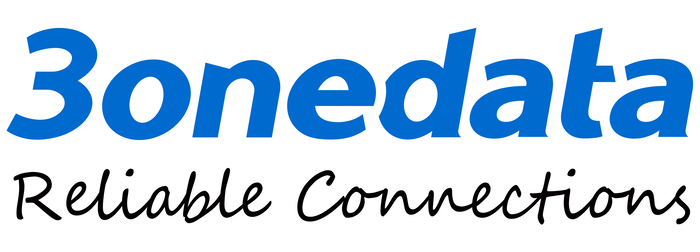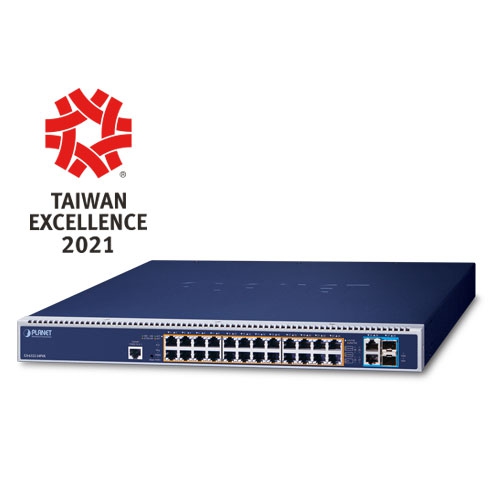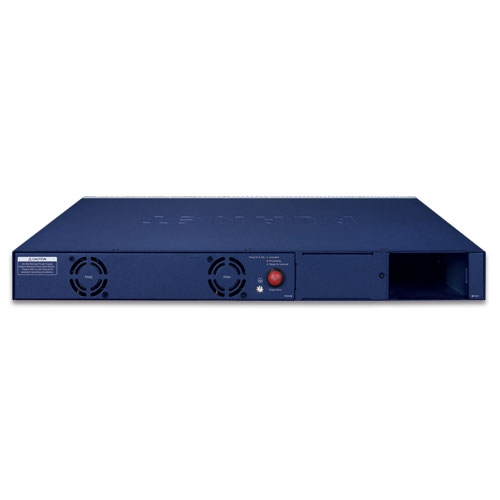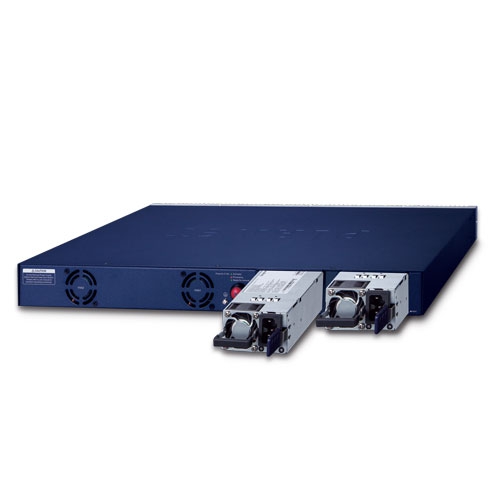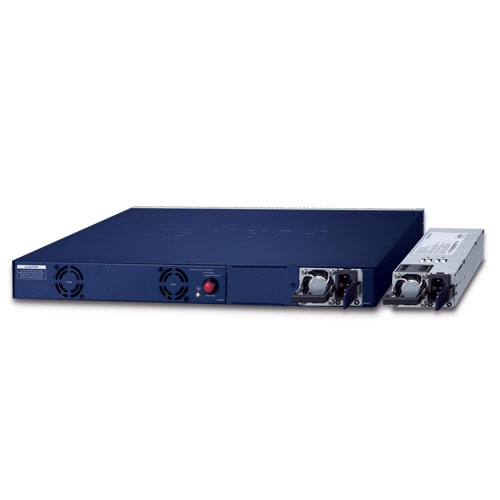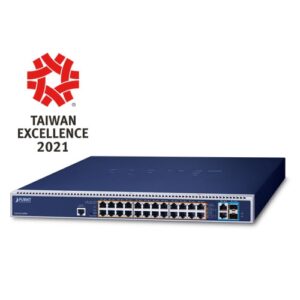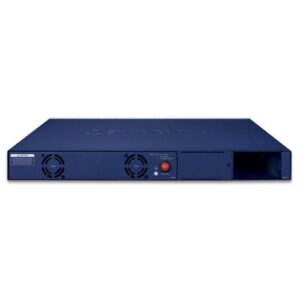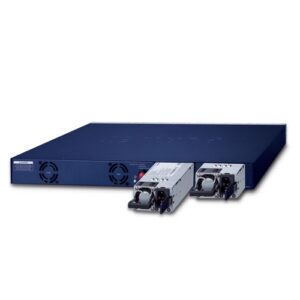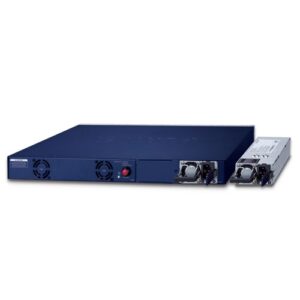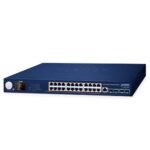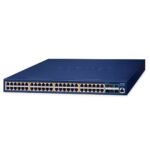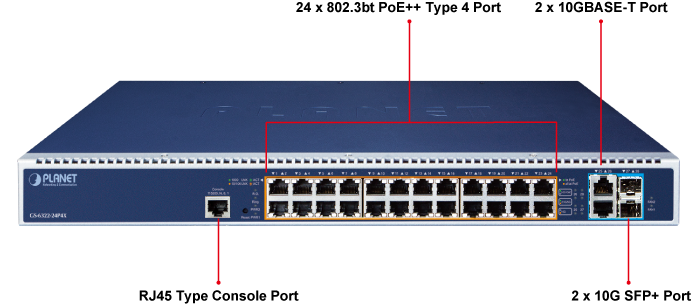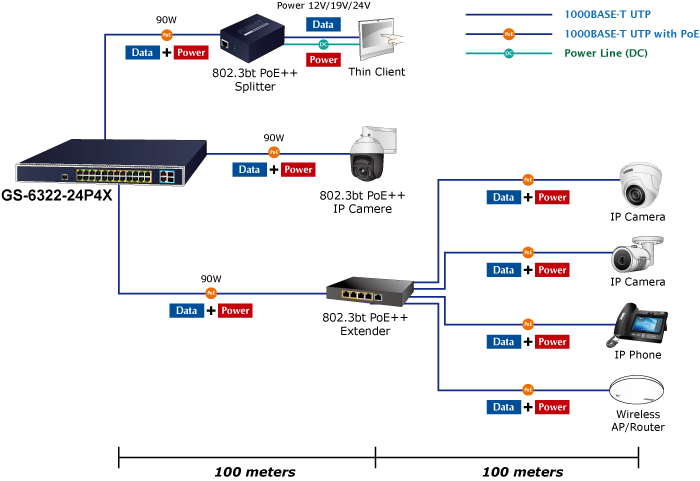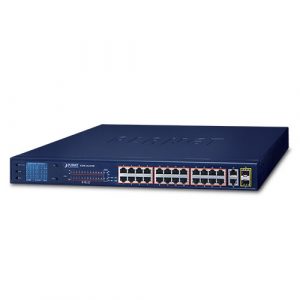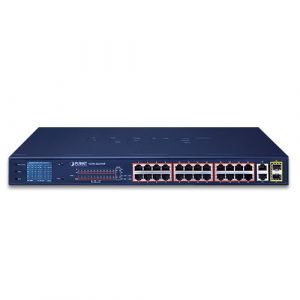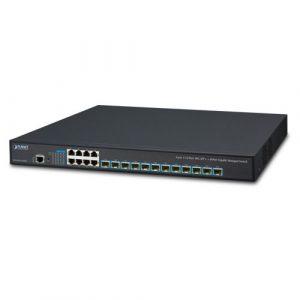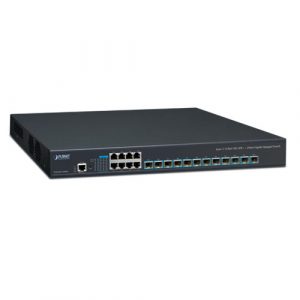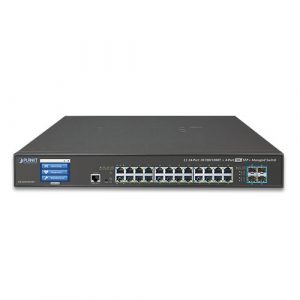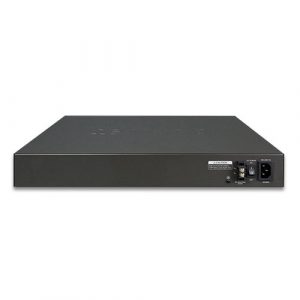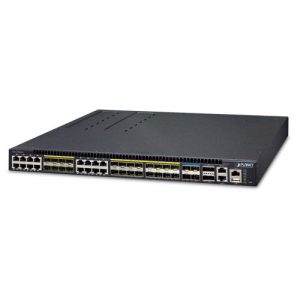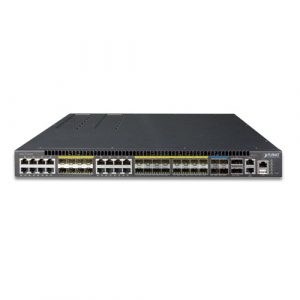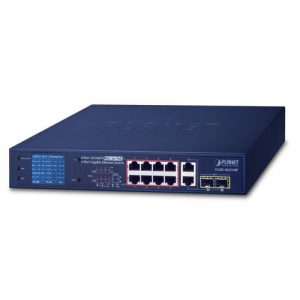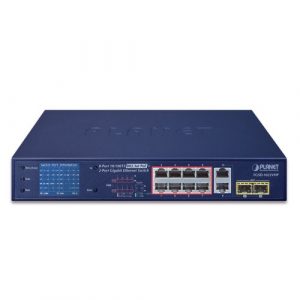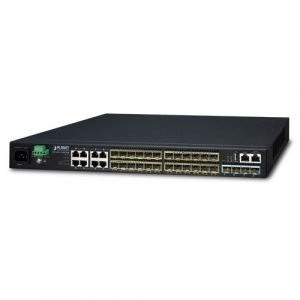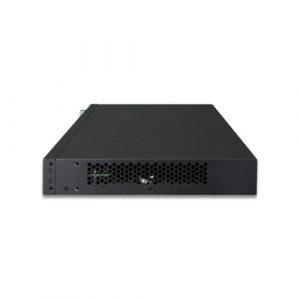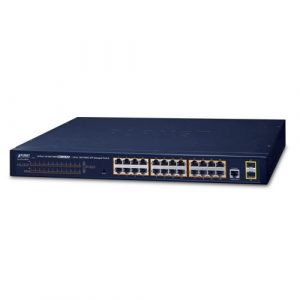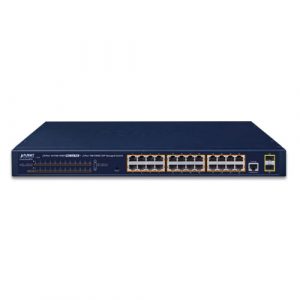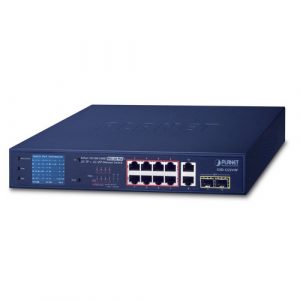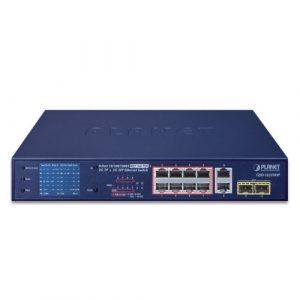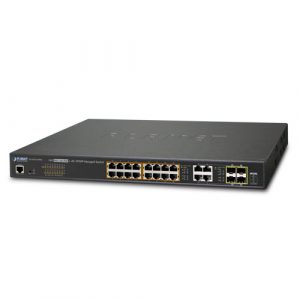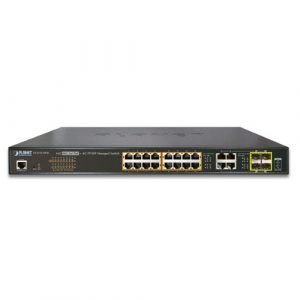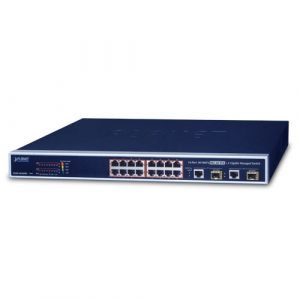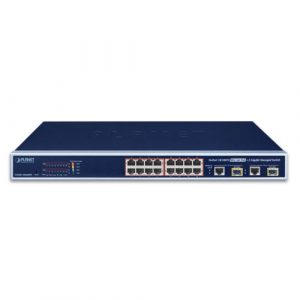GS-6322-24P4X
L3 24-Port 10/100/1000T 802.3bt PoE + 2-Port 10GBASE-T + 2-Port 10G SFP+ Managed Switch with Dual Modular Power Supply Slots
- Applicazioni
- DOWNLOAD
- SPECIFICHE
Descrizione
Potente switch gestito 802.3bt PoE++ con capacità di potenza estremamente elevata
PLANET GS-6322-24P4X Switch 802.3bt PoE++ completamente gestito con espandibilità a due slot di alimentazione modulari che promuove l’efficienza e la flessibilità della gestione dell’alimentazione in reti su larga scala, come aziende, hotel, centri commerciali, edifici governativi e altre aree pubbliche. Supporta modalità di funzionamento PoE avanzate, tra cui 24 porte PoE++ 802.3bt tipo 4 da 90 watt, modalità PoH (Power over HD-BASE-T) da 95 watt e modalità forzata a 4 coppie per risolvere l’incompatibilità dei PD PoE a 4 coppie non standard sul campo. Con un budget di potenza totale fino a 2.280 watt per diversi tipi di applicazioni PoE pesanti, GS-6322-24P4X fornisce una soluzione di rete PoE 802.3bt rapida, sicura e conveniente per piccole aziende e aziende.
Progettazione dell’alimentatore estrattivo per aumentare la flessibilità
Il GS-6322-24P4X è progettato con due slot per moduli di alimentazione estrattivi per supportare la modalità Redundant Power Supply (RPS) o la modalità Extended Power Supply (EPS) tramite impostazione software per gestire le richieste di ridondanza di alimentazione o alimentazione aggiuntiva per le porte PoE++, se necessario.
Modalità RPS (1+1): quando i servizi critici sono supportati dall’applicazione PoE, è necessaria la PSU secondaria per fornire alimentazione di backup in caso di interruzione di corrente. Quando sono installate due PSU, il budget di alimentazione è lo stesso di quello di una PSU.
Modalità EPS (2+0): quando è necessario un budget PoE maggiore per supportare l’applicazione completa, la PSU secondaria può fornire alimentazione PoE aggiuntiva. Le due PSU combinate sono in grado di fornire un massimo di alimentazione PoE totale.
Il GS-6322-24P4X può funzionare con tre alimentatori CA opzionali da 920 W/1200 W/2000 W. Gli utenti possono utilizzare in modo flessibile una o due fonti di alimentazione in base alla loro applicazione. Il suo sistema di alimentazione ridondante ed esteso flessibile è specificamente progettato per strutture ad alta tecnologia che richiedono la massima integrità di potenza.
Ad esempio:
Gestione della modalità di uscita di potenza PoE++ 802.3bt da 90~95 watt e avanzata PoE
Poiché il GS-6322-24P4X adotta lo standard PoE++ 802.bt IEEE e la tecnologia PoH, è in grado di fornire fino a 95 watt di potenza utilizzando tutte e quattro le coppie di cavi Ethernet Cat5e/6 standard per fornire potenza e dati a piena velocità a ciascun dispositivo remoto alimentato conforme a PoE (PD). Per soddisfare la domanda di vari dispositivi alimentati che consumano potenza PoE stabile, lo switch PoE++ GS-6322-24P4X offre cinque diverse modalità di uscita di potenza PoE tra cui scegliere.
- UPOE/PoH da 95 W
- PoE++ 802.3bt da 90 W
- Forza da 60 W
- PoE end-span da 36 W
- PoE mid-span da 36 W
Supporto di routing Layer 3
GS-6322-24P4X consente all’amministratore di aumentare comodamente l’efficienza della rete configurando manualmente il routing statico VLAN IPv4/IPv6 Layer 3 e le impostazioni IPv4 OSPFv2 (Open Shortest Path First) automaticamente. OSPF è un protocollo di routing dinamico interno per sistemi autonomi basato sullo stato del collegamento. Il protocollo crea un database per lo stato del collegamento scambiando gli stati del collegamento tra switch Layer 3 e quindi utilizza l’algoritmo Shortest Path First per generare una tabella di routing basata su tale database.
Soluzione di rete IEEE 802.3bt/Ultra PoE
PLANET GS-6322-24P4X può facilmente creare una soluzione di rete ultra PoE sul sistema di sicurezza informatica per le aziende. Ad esempio, può funzionare con il sistema POS e il thin client per eseguire una protezione di sicurezza completa per le aziende odierne. Il GS-6322-24P4X e lo splitter PoE++ 802.3bt POE-173S/IPOE-173S funzionano in coppia per fornire il modo più semplice per alimentare i dispositivi Ethernet che necessitano di un elevato input di potenza. Ricevendo dati e alimentazione dal GS-6322-24P4X, il POE-173S/IPOE-173S separa i dati digitali e l’alimentazione in diverse uscite opzionali (12 V, 19 V o 24 V CC) per dispositivi non PoE quali laptop, thin client, sistemi POS, telecamere di rete PTZ (pan, tilt e zoom), telecamere speed dome PTZ, telefoni IP con touchscreen a colori, punti di accesso LAN wireless multicanale e altri dispositivi di rete a una distanza fino a 100 metri.
Anello ridondante ottimale per un ripristino più rapido della rete gestita
GS-6322-24P4X supporta la tecnologia ad anello ridondante e presenta una capacità di auto-ripristino rapida e potente per prevenire interruzioni e intrusioni esterne. Incorpora la tecnologia avanzata ITU-T G.8032 ERPS (Ethernet Ring Protection Switching) e Spanning Tree Protocol (802.1w RSTP) nella rete del cliente per migliorare l’affidabilità del sistema e i tempi di attività in ambienti difficili. In una determinata rete ad anello semplice, il tempo di ripristino potrebbe essere inferiore a 10 ms per ripristinare rapidamente la rete, consentendo così alla rete di gestione di continuare a funzionare.
| Hardware Specifications | |
|---|---|
| Copper Ports | 24 10/100/1000BASE-T RJ45 auto-MDI/MDI-X ports 2-port 10GBASE-T RJ45 auto negotiation (Port-25 to Port-26), supports 10G/5G/2.5G/1G/100Mbps data rate |
| SFP+ Slots | 2 10GBASE-SR/LR SFP+ interfaces (Port-27 to Port-28) Compatible with 1000BASE-SX/LX/BX SFP and 2.5G SFP transceiver |
| Console | 1 x RS232-to-RJ45 serial port (115200, 8, N, 1) |
| Reset Button | < 5 sec: System reboot > 5 sec: Factory default |
| Dimensions (W x D x H) | 444 x 301 x 44mm, 1U height |
| Weight | 5478g |
| Power Requirements | Single 2000W PSU: AC 100~240V, 50/60Hz, 13A Dual 2000W PSUs: AC 100~240V, 50/60Hz, 26A |
| Power Consumption | Single PSU: Max. 2032 watts/ 6933 BTU Dual PSUs in EPS mode: Max. 2377 watts/ 8111 BTU |
| ESD Protection | 6KV DC |
| Fan | 2 smart fans |
| LED | System: SYS (Green) PWR1 (Green) PWR2 (Green) Ring (Green) Fan1/2/3 Alert (Red) PoE PWR Alert (Red) PoE Ethernet Interfaces (Port-1 to Port-24): af/at PoE (Orange) bt PoE/UPOE (Green) Ethernet Interfaces (Port-1 to Port-24): 1000 LNK/ACT (Green), 10/100 LNK/ACT (Orange) 1/10G SFP+ Interfaces (Port-27 to Port-28): 1G (Green), 10G (Orange) |
| Network Cables | 10G/5G/2.5G/1G/100M BASE-T: -10G – Cat 6A/7 -5G – Cat 6/6A/7 -1G/2.5G – Cat 5e/6/6A/7 -100M – Cat 5/5e/6/6A/7 -Cat 5/5e/6/6A/7 UTP cable (maximum 100 meters) 10GBASE-LR/SR/BX: -50/125μm or 62.5/125μm multi-mode fiber optic cable, up to 300m -9/125μm single-mode fiber optic cable, up to 60km |
| Switching | |
| Switch Architecture | Store-and-Forward |
| Switch Fabric | 128Gbps/non-blocking |
| Throughput | 95.23Mpps@64Bytes |
| Address Table | 16K entries, automatic source address learning and aging |
| Shared Data Buffer | 32M bits |
| Flow Control | IEEE 802.3x pause frame for full duplex Back pressure for half duplex |
| Jumbo Frame | 10K bytes |
| Power over Ethernet | |
| PoE Standard | 802.3bt PoE++ PSE Backward compatible with IEEE 802.3af/802.3at PoE PSE |
| PoE Power Supply Type | 802.3bt UPoE End-span Mid-span Force |
| PoE Power Output | Per port 54V DC -802.3bt Type-4 mode, Port-1 to Port-24: maximum 90 watts -UPoE mode, Port-1 to Port-24: maximum 95 watts -End-span mode: maximum 36 watts -Mid-span mode: maximum 36 watts -Force mode: maximum 60 watts |
| Power Pin Assignment | 802.3bt: 1/2(-), 3/6(+), 4/5(+), 7/8(-) UPoE: 1/2(-), 3/6(+), 4/5(+), 7/8(-) End-span: 1/2(-), 3/6(+) Mid-span: 4/5(+), 7/8(-) |
| PoE Power Budget | up to 2280 watt |
| PoE Management Functions | |
| Active PoE device alive detects | Yes |
| PoE Power Recycle | Yes, daily or predeinded schedule |
| PoE Schedule | 4 schedule profiles |
| PoE Extend Mode | Yes, max. 160 to 200 meters |
| PoE System Management | System PoE Admin control Total PoE power budget control Auto power input and PoE budget control PoE Legacy mode Over-termperature threshold alarm PoE usage threshold alarm |
| PoE Port Management | Port Enable/Disable/Schedule PoE mode control – 802.3bt – UPoE – 802.3at End-span – 802.3at Mid-span Force mode Port Priority |
| Layer 3 Functions | |
| IP Interfaces | Max. 128 VLAN interfaces |
| Routing Table | Max. 128 routing entries |
| Routing Protocols | IPv4 OSPFv2 IPv4 hardware static routing IPv6 hardware static routing |
| Layer 2 Management Functions | |
| Port Configuration | Port disable/enable Auto-negotiation 10/100/1000Mbps full and half duplex mode selection Flow control disable/enable Port link capability control |
| Port Status | Display each port’s speed duplex mode, link status, flow control status, auto-negotiation status, trunk status |
| Port Mirroring | TX/RX/Both Many-to-1 monitor |
| VLAN | 802.1Q tagged VLAN Q-in-Q tunneling Private VLAN Edge (PVE) MAC-based VLAN Protocol-based VLAN Voice VLAN MVR (Multicast VLAN registration) Up to 4K VLAN groups, out of 4095 VLAN IDs |
| Link Aggregation | IEEE 802.3ad LACP/static trunk Supports 3 trunk groups with 4 ports per trunk group |
| Spanning Tree Protocol | IEEE 802.1D Spanning Tree Protocol (STP) IEEE 802.1w Rapid Spanning Tree Protocol (RSTP) IEEE 802.1s Multiple Spanning Tree Protocol (MSTP) |
| IGMP Snooping | IPv4 IGMP (v1/v2/v3) snooping IPv4 IGMP querier mode support Supports 255 IGMP groups |
| MLD Snooping | IPv6 MLD (v1/v2) snooping, IPv6 MLD querier mode support Supports 255 MLD groups |
| QoS | Traffic classification based, strict priority and WRR 8-level priority for switching: – Port number – 802.1p priority – 802.1Q VLAN tag – DSCP/ToS field in IP packet |
| Access Control List | IP-based ACL/MAC-based ACL ACL based on: – MAC Address – IP Address – Ethertype – Protocol Type – VLAN ID – DSCP – 802.1p Priority Up to 256 entries |
| Bandwidth Control | Per port bandwidth control Ingress: 100Kbps~1000Mbps Egress: 100Kbps~1000Mbps |
| RING | Support ERPS, complies with ITU-T G.8032 Recovery time < 10ms with 3 units Recovery time < 50ms with 16 units |
| Management | |
| Basic Management Interfaces | Console Telnet Web browser SNMP v1, v2c |
| Secure Management Interfaces | SSHv2, TLSv1.2, SSL, SNMP v3 |
| SNMP MIBs | RFC 1213 MIB-II RFC 1493 Bridge MIB RFC 1643 Ethernet MIB RFC 2863 Interface MIB RFC 2665 Ether-Like MIB RFC 2819 RMON MIB (Groups 1, 2, 3 and 9) RFC 2737 Entity MIB RFC 2618 RADIUS Client MIB RFC 2863 IF-MIB RFC 2933 IGMP-STD-MIB RFC 3411 SNMP-Frameworks-MIB RFC 4292 IP Forward MIB RFC 4293 IP MIB RFC 4836 MAU-MIB IEEE 802.1X PAE LLDP MAU-MIB |
| Standards Conformance | |
| Regulatory Compliance | FCC Part 15 Class A, CE |
| Standards Compliance | IEEE 802.3 10BASE-T IEEE 802.3u 100BASE-TX/100BASE-FX IEEE 802.3z Gigabit SX/LX IEEE 802.3ab Gigabit 1000T IEEE 802.3ae 10Gb/s Ethernet IEEE 802.3x flow control and back pressure IEEE 802.3ad port trunk with LACP IEEE 802.1D Spanning Tree Protocol IEEE 802.1w Rapid Spanning Tree Protocol IEEE 802.1s Multiple Spanning Tree Protocol IEEE 802.1p Class of Service IEEE 802.1Q VLAN tagging IEEE 802.1x Port Authentication Network Control IEEE 802.1ab LLDP IEEE 802.3af Power over Ethernet IEEE 802.3at Power over Ethernet Plus IEEE 802.3bt PoE++ Power over Ethernet Plus Plus IEEE 802.3ah OAM IEEE 802.1ag Connectivity Fault Management (CFM) RFC 768 UDP RFC 793 TFTP RFC 791 IP RFC 792 ICMP RFC 2068 HTTP RFC 1112 IGMP v1 RFC 2236 IGMP v2 RFC 3376 IGMP v3 RFC 2710 MLD v1 FRC 3810 MLD v2 RFC 2328 OSPF v2 ITU-T G.8032 ERPS Ring ITU-T Y.1731 Performance Monitoring |
| Environment | |
| Operating | Temperature: 0 ~ 50 degrees C Relative Humidity: 5 ~ 95% (non-condensing) |
| Storage | Temperature: -10 ~ 70 degrees C Relative Humidity: 5 ~ 95% (non-condensing) |


